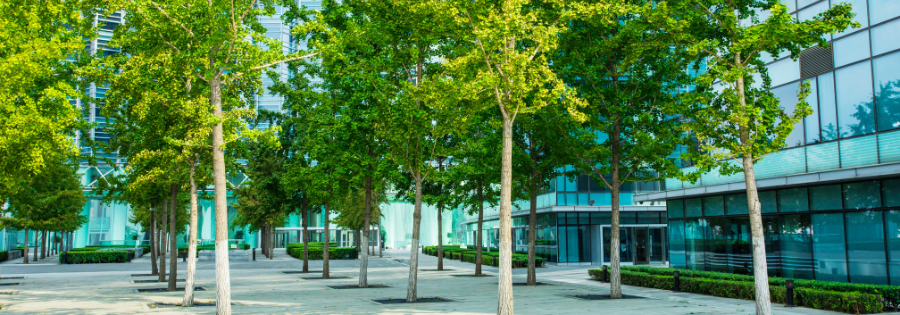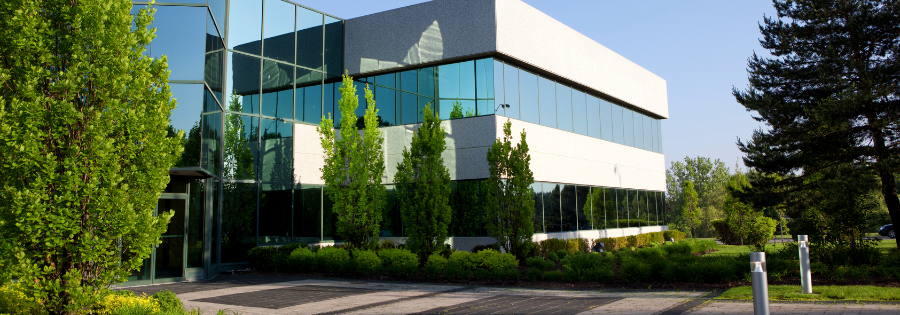What Happens When Trees Get Planted Too Close to Buildings?

The commercial landscaping professionals at Coastal Spray have seen firsthand the beauty and benefits that trees can bring to our urban environments. However, when trees are planted too close to buildings, they can also pose a range of challenges and potential hazards that business owners should be aware of.
Potential Risks and Challenges of Planting Trees Near Buildings
While trees provide numerous benefits, such as enhancing aesthetics and improving air quality, when they are located too close to houses or businesses, it can lead to various issues for the property owner.
Structural Damage
One of the most immediate concerns with trees planted too close to commercial buildings is the risk of damage to the structures themselves. Tree roots have a powerful ability to seek out sources of water and nutrients, which often leads them to penetrate foundations, sidewalks, and even underground utility lines. This can result in costly damage repairs and pose safety risks to employees, customers, and visitors.
Exterior Damage
Additionally, as trees grow, their branches can encroach upon the building, causing abrasion to walls, windows, and roofing materials. This not only detracts from the appearance of the property but can also compromise the integrity of the building envelope, leading to leaks and moisture-related issues over time.
Decreased Visibility and Natural Light
Another consideration is the potential for obstructed views and limited natural light penetration into the building. While trees are valued for their ability to provide shade and create a pleasant outdoor environment, when they are planted too close to windows or entryways, they can obstruct sightlines and reduce visibility from inside the building. This can have a negative impact on employee productivity and customer experience, particularly in retail or hospitality settings where visibility plays a crucial role in attracting foot traffic.
Maintenance Challenges
Furthermore, trees planted too close to commercial buildings can create maintenance challenges for property owners and managers. Overhanging branches may require frequent pruning to prevent them from interfering with signage, lighting fixtures, or other exterior elements. Additionally, the accumulation of leaves, twigs, and debris on roofs and in gutters can exacerbate drainage issues and increase the risk of water damage during heavy rainstorms.
How Far Should Your Trees Be from the Side of Your Building?

Factors to Consider:
- Root Spread: Tree roots have a natural tendency to spread outwards in search of water and nutrients. Planting trees too close to the building can lead to root intrusion into the foundation, which may compromise the structural integrity over time.
- Branch Encroachment: The canopy of a tree also requires adequate space to grow without encroaching upon the building. Branches that come into contact with the structure can cause abrasion and damage to exterior surfaces, as well as obstruct views and limit natural light penetration.
- Building Height: The height of the building should also be taken into account when determining the appropriate distance for tree planting. Taller buildings may require greater clearance to prevent branches from overhanging or impacting the structure.
Recommended Distances:
While specific recommendations may vary depending on factors such as tree species, building design, and local climate conditions, a general guideline is to plant trees at least:
- 15 to 20 feet away from low-rise buildings: For single-story or low-rise commercial buildings, trees should be situated a minimum of 15 to 20 feet away from the side of the structure to allow ample space for root and canopy growth.
- 25 to 30 feet away from mid-rise buildings: For mid-rise buildings with multiple stories, a greater distance of 25 to 30 feet may be advisable to accommodate the height of the building and prevent branch encroachment.
- 30 feet or more from high-rise buildings: High-rise buildings typically require even greater clearance due to their height and potential wind exposure. Trees should be planted at least 30 feet or more away from the side of high-rise structures to minimize risks of structural damage and maintenance challenges.
Consult the Professionals!
When in doubt, it’s always best to consult with experienced landscaping professionals, such as Coastal Spray, who can assess the specific conditions of your property and provide tailored recommendations for tree placement. By working closely with experts, you can ensure that your landscaping enhances the beauty and functionality of your commercial property while minimizing potential risks and liabilities associated with trees planted too close to buildings.
Expert Landscaping Solutions from Coastal Spray
From strategic tree placement and species selection to ongoing monitoring and pruning, Coastal Spray works closely with our clients to create sustainable landscaping solutions that enhance the beauty and functionality of their properties while minimizing potential risks and liabilities.
If you’re a business owner or property manager grappling with the challenges of trees planted too close to your commercial building, we’re here to help. Contact Coastal Spray today to schedule a consultation with one of our knowledgeable arborists and discover how we can assist you in achieving your landscaping goals.
Don’t let trees become a liability for your business. Trust Coastal Spray to keep your commercial property looking its best for years to come!